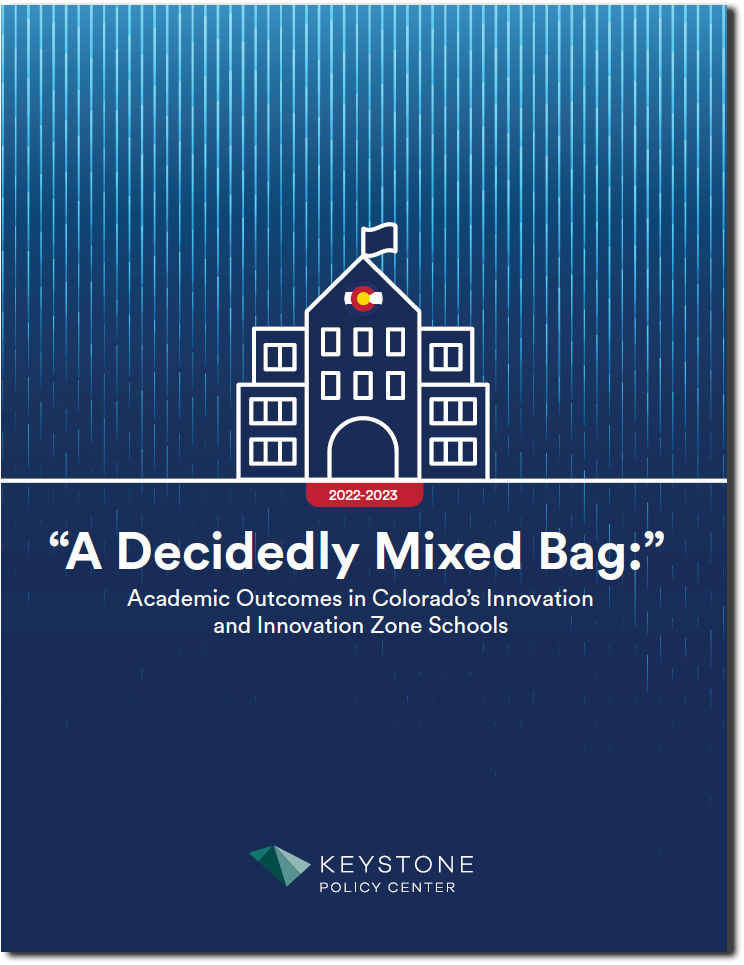“A Decidedly Mixed Bag:” Academic Outcomes in Colorado’s Innovation and Innovation Zone Schools
Overview
The Innovation Schools Act of 2008 (ISA) requires the Colorado Department of Education (CDE) to submit to the Governor an annual report summarizing the demographics of students being served in innovation schools and zones statewide, providing key autonomies granted, cataloging performance by each innovation school over time, and recommending any desired legislative changes.
This report compiles and analyzes CDE’s information with specific state testing results (Colorado Measures of Academic Standards or “CMAS”, and Colorado SAT or “PSAT/SAT”) outcomes for innovation schools from the 2022-2023 school year. It does so on a disaggregated basis for Black and Hispanic students and those experiencing poverty, as measured by qualification for free or reduced lunch (“FRL”.)
Colorado’s innovation sector produced a decidedly mixed bag of results based on these measures. In some areas, the results these schools created for students were truly subpar, as compared to outcomes generated by district-managed and charter schools across the state. Moreover, the holistic data story here indicates quite clearly that all public schools in Colorado, regardless of type, must improve their collective service to students significantly, and with urgency.
This report opens with introductory context that delves into the history of the ISA and a brief overview of innovation schools now operating in Colorado, before digging into findings related to academic outcomes these schools created for students in 2022-2023.
Summary of Findings
A brief summary of the findings in the report includes:
- Overall innovation schools have lower CMAS proficiency rates in both ELA and math when compared to all other governance types. Innovation zone schools’ proficiency rates are above those of traditional innovation schools, but also below other governance types.
- A smaller proportion of innovation schools met growth expectations (Median Growth Percentile, or “MGP” over 50) than other governance types in ELA and math. Innovation zone schools saw a higher proportion of schools meet this threshold when compared to district-managed schools but still fell short of the charter sector.
- Innovation and innovation zone schools had lower proportions of high school students meeting expectations than both charter and district-managed schools. In math only 15% of innovation school students in grades 9-11 met expectations on PSAT/SAT, compared to over 40% in charter and district-managed schools.
- The large majority of innovation and innovation zone high schools did not meet growth expectations in 2023 (MGP of 50.) Over 90% of innovation schools fell short of this benchmark in ELA and over 80% in math. This means that innovation high school students are, on average, falling further behind their peer statewide with comparable prior performance levels.
- There is a strong correlation between the percent of free and reduced lunch (FRL) eligible students served and proficiency rates on CMAS, with few outliers.
- In ELA, innovation schools outperformed district managed schools in terms of Black and Hispanic student proficiency, although they still lagged behind charter schools. In math, their performance was slightly below or on par with district-managed schools and once again lagged behind charter schools by a larger margin for both Black and Hispanic students.
- On PSAT/SAT, innovation school students of all three highlighted race/ethnicities lagged other governance types across both subjects. This indicates that innovation high schools are not only not serving students well overall, academic gaps are likely widening within these schools.
- FRL students in innovation schools outperform students in District managed schools by a small margin, though they lag behind charters by a similar margin, in both ELA and math.
- FRL students in innovation high schools performed behind their peers in schools of all governance types in both ELA and math, another indicator of the challenges being seen in innovation high schools across data points.
Click here to further explore the Innovation schools data for Denver.
The report concludes with a set of policy and research questions raised by the findings.










